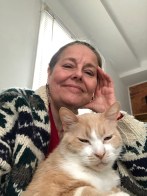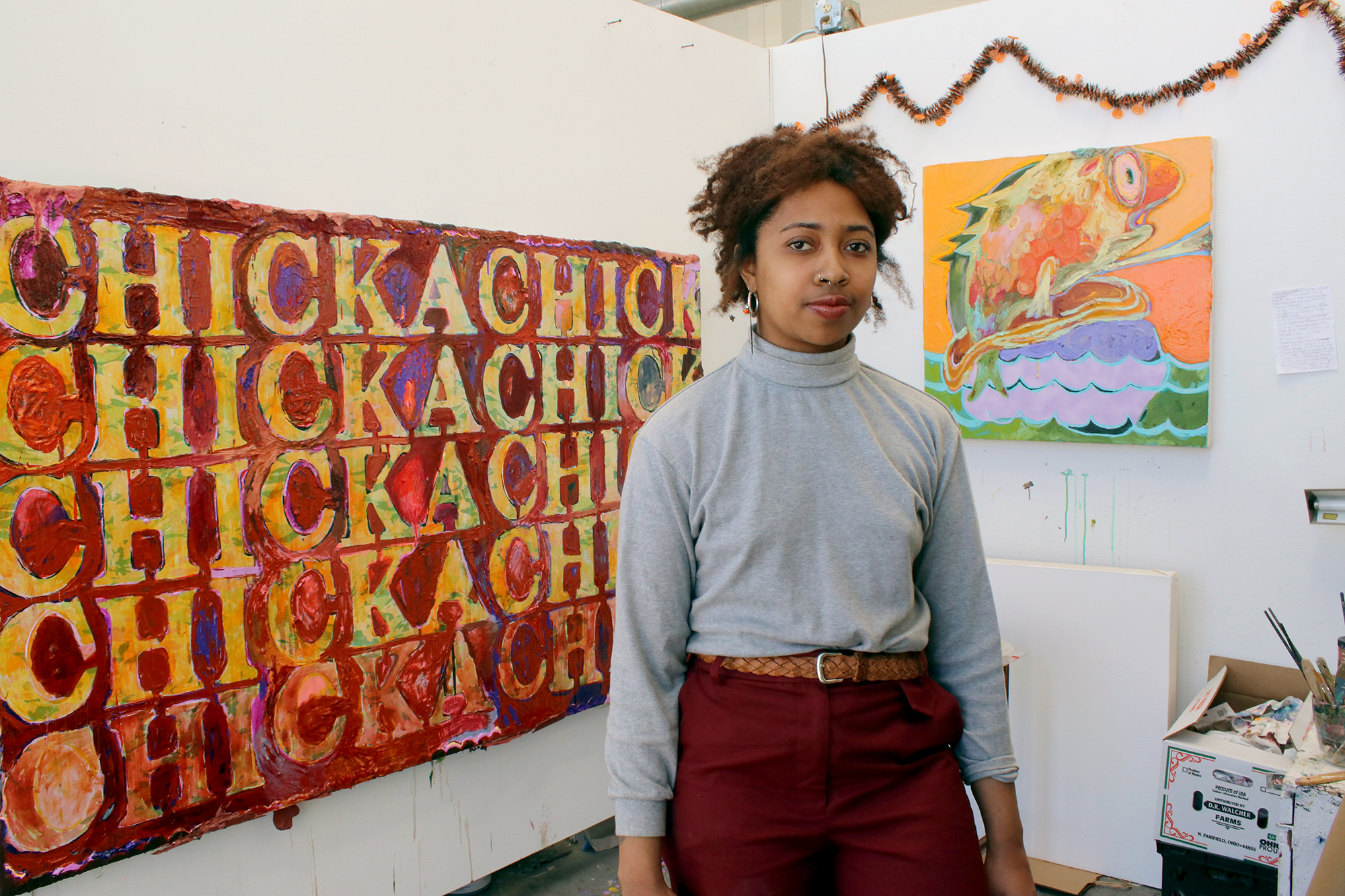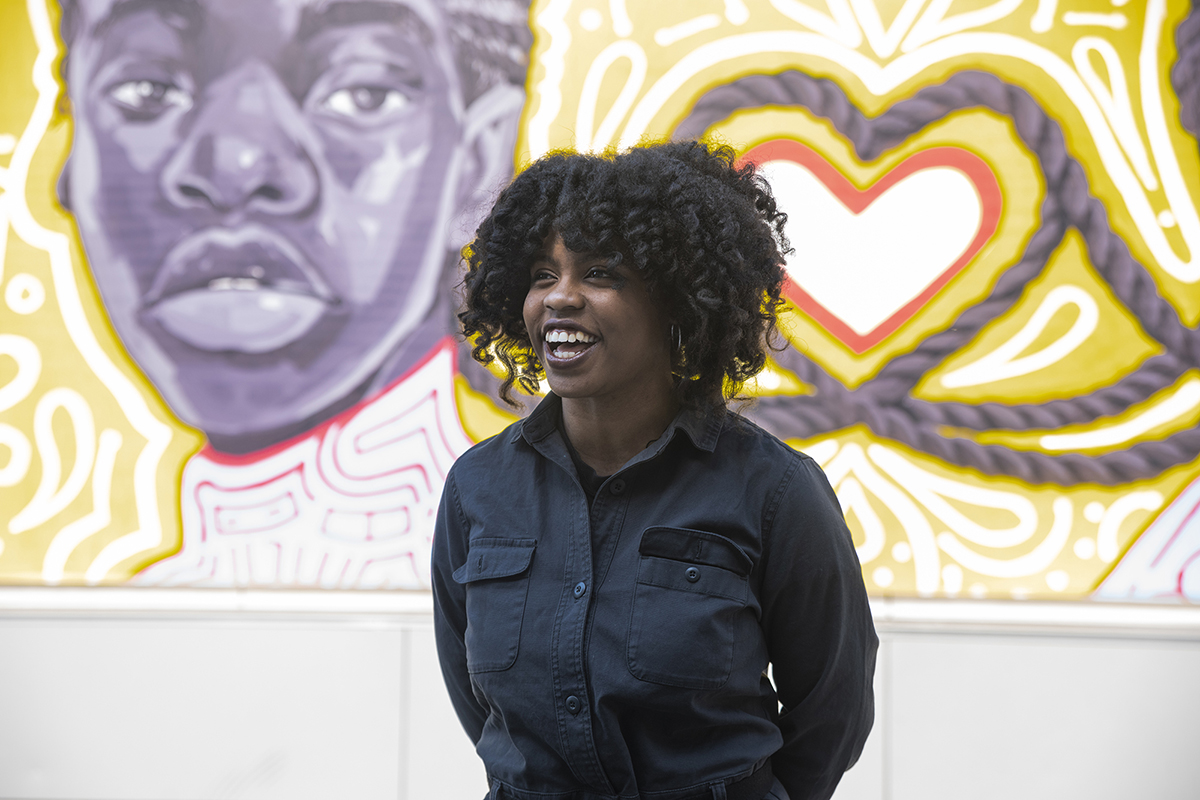Years 25 • Lives and creates Cleveland Heights • Learned BFA from Cleveland Institute of Art
Story and photography by Amanda Koehn
Davon Brantley’s portraits can draw in a passing viewer with just three elements: their polish, precise colors and unique textures.
It only takes seconds to see there is so much more going on. A striking combination of mythological and Christian imagery, and complex psychological narratives make it hard to look away.
For the 25-year-old artist who creates out of his Cleveland Heights home, ideas come from personal history and trauma.
Davon Brantley’s portraits can draw in a passing viewer with just three elements: their polish, precise colors and unique textures.
“Where I start is, usually I recount back my childhood – especially the trauma that I experienced,” he says. “When I recount those experiences, I go into my family book which has just general family photos and that kind of stuff, and I’ll pick out which ones have a vibrant or interesting color scheme, and I’ll choose ones that have a great composition – where the people are communicating with each other or they are interacting with each other in a specific way.”
Then, he recreates the photos to express his vision, mood and feelings. He draws from a psychiatric term, dissociative identity disorder, which refers to a mental disorder experienced overwhelmingly by people who have experienced trauma and who psychologically separate into different identities. Thus, some pieces take on a manic, happy personality, while others depict depressive episodes and others, a more neutral, yet hopeless romantic character.
“I see them inside myself, so I manifest it into paintings and drawings,” he says. “But I also see these (identities) as not necessarily a problem, but something that’s common among others as well.”
Brantley says he loved art as a kid growing up mostly in the eastern Cleveland suburbs. He jokes about getting into “a little bit of trouble” as a high schooler, selling his art inside school.
Wanting to “ace every subject though to get a good GPA to get into a good college,” he seriously gravitated toward art during his senior year. He sought a mentor in an art teacher who helped him develop his portfolio, despite him never taking a formal art class.
When he first got to the Cleveland Institute of Art, his work was “surface level,” he says. Dealing with and talking about traumatic childhood experiences, he began to work through them in his artwork.
“I think that I really grew as an artist when I started to discover myself, and I started seeing a therapist about all these problems and just made art my modality,” Brantley says, adding that he sees studying and working in art therapy in his future.

Two years after graduating from CIA, the pandemic has been a time of creative inspiration and productivity for the artist. In response to the rise of the Black Lives Matter movement that aims to reckon with and reform our country’s long history of systemic racism and racist violence by law enforcement, Brantley saw several opportunities to create commissioned murals. He was among a group of local artists, organized by Graffiti HeArt and Random Acts of Kindness Everywhere, in June that painted a “Black Lives Matter” mural on East 93rd Street in Cleveland.
From that, more mural opportunities came to Brantley, including at the West Side Catholic Center in Cleveland and on a wall along the railroad tracks in Bedford, the latter of which invoked the history of the Underground Railroad in Bedford and was also organized by Graffiti HeArt.
“Then since the murals – that was kind of like a new thing for me – I already had certain exhibitions set up that couldn’t happen when the pandemic started,” he says. “And so after the murals and during the murals, those organizations opened back up their galleries.”
Since, he’s shown his work at the Waterloo Arts DayGlo show in Cleveland, Mahall’s in Lakewood and Artists Archives of the Western Reserve in Cleveland. He also has solo shows planned for Young’s Art Center in Fairview Park in January and BAYarts in Bay Village in August.
His current work is increasingly focused on experiences of racism, colorism, contemplating life and death, “and how being a Black man … kind of gives you a different perspective on how to handle those issues.”
“I’ve created a lot of stuff that deals with those topics, kind of showing people what I actually feel as an African American male, the injustices that I see and I deal with on a day-to-day basis,” he says.
He says some of that work has focused on the idea of “subverting a lot of the dark fantasies” stereotypically attributed to people of color. For example, he points to a painting with themes of lust and greed – but not what one may commonly associate with those words.
“It will be more so about someone’s lust for care, life and having a heart and emotion, and trying to protect that at all costs, even though it seems like it’s pouring out of them at an exponential rate,” he says.
He shows another piece – a 7-foot drawing of himself, made into a hoodie Brantley wears – inspired by religious Renaissance era work. A red dot encircles the subject’s head, which could resemble either a halo or the red target one sees when looking down the barrel of a gun – reflecting how Black Americans are targeted by law enforcement. A black square surrounds his body, as a nod to the “blackout” social media trend to shift attention to Black voices and pain. But in the drawing, “I made the Black body visible, so you had no choice but to see it.”
“And I drew myself in kind of a more classical pose – I’m sitting upright and everything, and it kind of just makes you think about the absence of African Americans in Renaissance paintings, Baroque paintings, art history and in general the lack of the stories being told about us,” he says.

“Some artists are really concerned with being trendy with their work. Davon’s not like that. He’s really emotionally raw and real. He’s constantly leaning into his work both in terms of how he makes it and in terms of putting it into the world. His work telegraphs out a very human experience. You don’t meet many artists that are just that forthright. His work is so satisfying to spend time with.”
Lane Cooper, associate professor, painting department, Cleveland Institute of Art
On view
• Brantley’s work will be on view through Dec. 6 at Mahall’s Museum of Creative Human Art, 13200 Madison Ave., Lakewood.
• “About Body | About Face,” which features Brantley and Ohio artists Lawrence Baker, Jacques P. Jackson, Amanda D. King, Yvonne Palkowitsh, LaSaundra Robinson and Tony Williams, will be on view through Jan. 16, 2021 at Artists Archives of the Western Reserve, 1834 E. 123rd St., Cleveland. Virtual artist talks will be held from 7 to 8:30 p.m. Dec. 2 and Dec. 9, with more information at artistsarchives.org.











